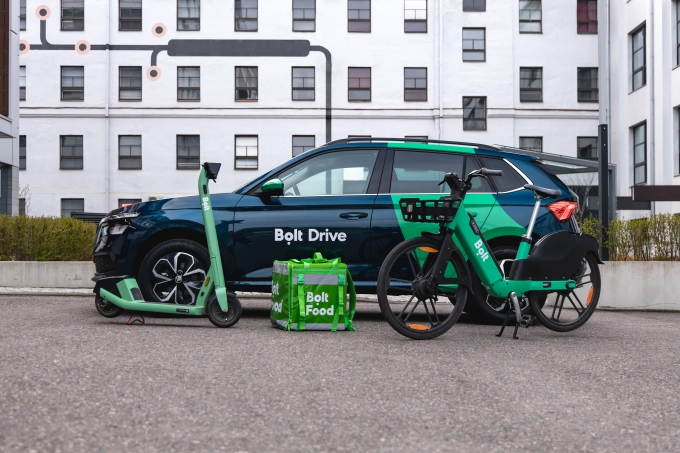Bolt receives $709 million at a $8.4 billion valuation to extend its smart app for transportation and food delivery

Economies of scale are critical for on-demand businesses, and one of the promising startups in the field has secured a large round to expand its operations.
Bolt, a startup and app that provides on-demand ride hailing, shared vehicles and scooters, as well as restaurant and grocery delivery, has raised €628 million at an estimated valuation of €7.4 billion ($8.4 billion). It will use the funds to expand to new geographies and attract more consumers and partners to its “super app”; and newer business lines, such as its 15-minute grocery delivery service Bolt Market, will build out “dark stores” in more cities to expand the service beyond the ten where it is currently active.
“All of our business units are increasing,” said Markus Villig, the company’s founder and CEO, in an interview this week. Even its most mature business, ride hailing, is “seeing double digit growth,” according to Villig, while the newer businesses, which are smaller, are growing even faster. “A new trend from last year is that private vehicles are a negative thing, and people are increasingly wanting to use other modes of transportation.” Bolt is also working with more local governments to expand its services as part of their updated transportation goals, according to him.
Whale Rock, Owl Rock (a division of Blue Owl), D1, G Squared, Tekne, Ghisallo, and other unknown backers also participated in the round, which was co-led by Sequoia Capital, Fidelity Management, and Research Company LLC.
The investment revelation caps off an eventful few months for the company, which had only four months prior received €600 million in a Series E led by Sequoia at a valuation of over €4 billion. Bolt’s services are presently used by over 100 million people in 45 countries and 400+ cities. The company has 75 million customers in August, when it announced the last round, as a metric of its expansion.
Bolt’s development is also noteworthy in light of the challenges that some of its competitors have faced in the aftermath of COVID: The epidemic had a significant chilling impact on people’s willingness to get into a car and sit in a cramped space with another person (the driver).
That problem was then exacerbated when business started up again, but at such a rapid pace that many services are experiencing a driver scarcity rather than a passenger deficit.
When the lockdowns first began, Villig admitted that Bolt, too, experienced some “short-term fluctuations” in demand. However, it has made attracting and retaining drivers a priority by paying higher commissions than its competitors (typically, Villig said, it will pay between 10 percent and 20 percent better than competitors).
“Because there is such a scarcity of supply on these platforms,” he explained, “we have focused on choosing the most partner-friendly, lowest commission.” Bolt has seen monthly revenues more than double compared to pre-COVID sales, according to Villig.
Bolt was founded eight years ago in Tallinn, Estonia (originally as Taxify) with a mission to bring ride hailing to emerging markets and countries where others like Uber had yet to establish a strong foothold, a strategy that it used to modestly expand across regions like Central and Eastern Europe and Africa, attracting investors like China’s Didi, which had built a massive business in its own emerging market. (Didi secretly sold its Bolt investment last year.)
The focus has stayed on Europe and Africa over time, but Bolt discovered that many of the lessons learned from those early launches could be applied just as successfully in more industrialized countries, with more profitable payoffs.
“We started in Eastern Europe and Africa since those were the markets with the most demand.” It made sense because they had lower automobile ownership and increased unemployment [resulting in a market with many freelance drivers],” Villig explained. “But now we know that this model works everywhere, and that Western Europe is actually easier to grow in because it is a developed market.” We discovered that if you can make this model work in really cheap, frugal markets, it becomes materially easier once you get to London or Stockholm. And because the costs are greater, the unit economics are absolutely better.” However, it isn’t a perfect method. Working in established markets comes with “more restrictions” and the limitations that come with them, he noted.
Meanwhile, Bolt’s diversification strategy, which includes scooters, couriers, and now food delivery services in addition to automobiles, is part of its scaling strategy. Putting all of the alternatives and cross-promotions under a single app not only helps Bolt draw in new consumers and cross sell to them, but it also does so with basically zero marketing costs, according to Villig.
“Two elements that set us apart and are turning in our favor are the synergies and the shared costs between these verticals,” he said. Most of Bolt’s competitors are generally focused on one thing in each app, Villig continued, “and we are not,” so it’s easier and less expensive for Bolt to build more services off the back of each other. “Now we are passing on those savings for customers.”







